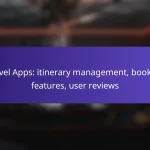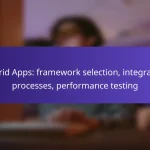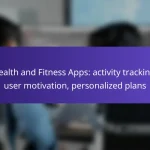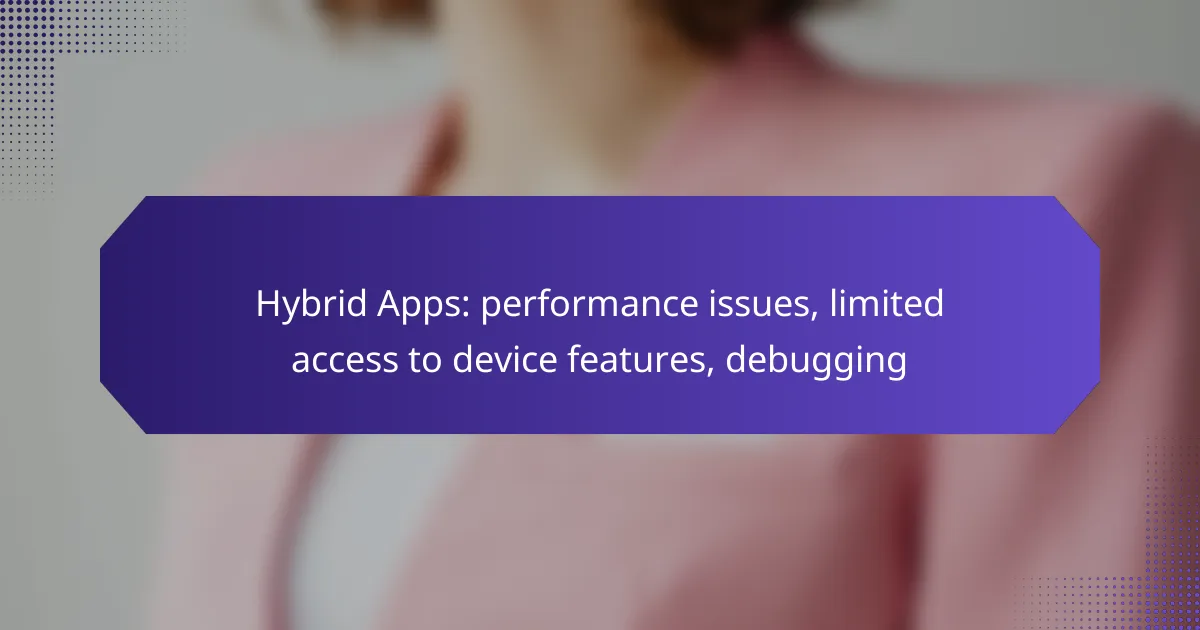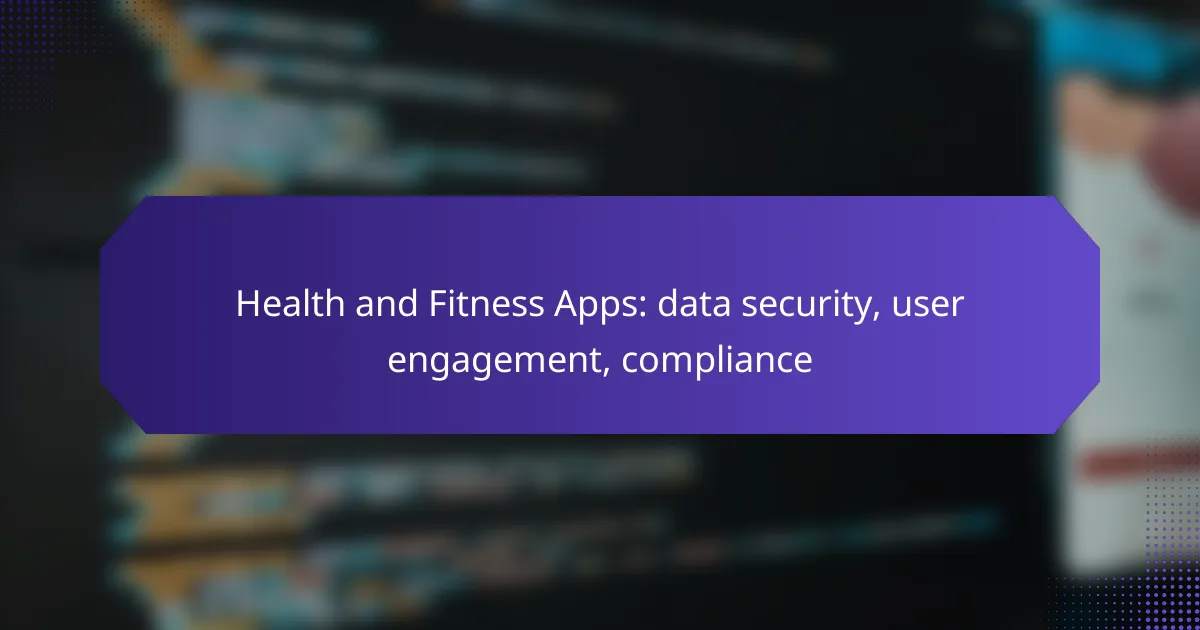Hybrid apps present unique challenges, particularly in terms of performance and access to device features. Users may experience slow loading times and inconsistent performance, which can detract from overall satisfaction. Additionally, these apps often have limited access to certain hardware capabilities, further impacting their functionality and user experience.

What are the performance issues of hybrid apps in the UK?
Hybrid apps in the UK often face several performance issues that can hinder user satisfaction and engagement. These challenges include slow loading times, inconsistent user experiences, and high memory usage, which can affect overall app functionality.
Slow loading times
Slow loading times are a common issue for hybrid apps, primarily due to the need for web technologies to render content. Users expect apps to load quickly, ideally within a few seconds; delays can lead to frustration and abandonment. Optimizing images, minimizing code, and leveraging caching can help mitigate these delays.
In the UK, where mobile internet speeds can vary, ensuring that hybrid apps load efficiently is crucial. Developers should regularly test performance across different devices and network conditions to identify bottlenecks.
Inconsistent user experience
Hybrid apps may deliver an inconsistent user experience because they rely on web views that can behave differently across platforms. This inconsistency can manifest in UI elements, navigation, and responsiveness, making the app feel less native. To address this, developers should prioritize platform-specific design guidelines and conduct thorough testing on various devices.
In the UK market, where users are accustomed to high-quality native apps, maintaining a seamless experience is essential for user retention and satisfaction.
High memory usage
High memory usage is another concern for hybrid apps, as they often load multiple libraries and frameworks simultaneously. This can lead to performance degradation, especially on devices with limited resources. Developers should monitor memory consumption during development and optimize the app by removing unnecessary libraries and assets.
In the UK, where users may have a range of devices with varying specifications, ensuring that hybrid apps run efficiently on lower-end models is vital to reach a broader audience.
Limited offline functionality
Hybrid apps typically have limited offline functionality compared to native apps, as they rely on constant internet connectivity for many features. This can be a significant drawback for users in areas with poor network coverage. Implementing local storage solutions and caching strategies can enhance offline capabilities, allowing users to access essential features without an internet connection.
In the UK, where users may travel through regions with fluctuating connectivity, improving offline functionality can significantly enhance user satisfaction.
Network dependency
Hybrid apps are often heavily dependent on network connectivity, which can lead to performance issues when the connection is slow or unstable. This dependency can result in slow loading times and a poor user experience. Developers should consider implementing features that allow the app to function with limited connectivity, such as queuing actions until a stable connection is available.
In the UK, where users frequently use mobile data, minimizing network dependency can improve the overall usability of hybrid apps, making them more appealing to a wider audience.

How can performance issues be resolved?
Performance issues in hybrid apps can be addressed through various strategies that enhance efficiency and responsiveness. Key approaches include optimizing code, utilizing native components, implementing caching, and conducting thorough performance testing.
Optimize code and assets
Optimizing code and assets is crucial for improving the performance of hybrid apps. This involves minimizing file sizes, reducing the number of HTTP requests, and using efficient coding practices. For example, compressing images and leveraging minification tools can significantly decrease load times.
Additionally, consider using asynchronous loading for scripts to prevent blocking the rendering of the app. Aim for a balance between functionality and performance, ensuring that the app remains responsive while delivering a rich user experience.
Use native components
Incorporating native components can enhance the performance of hybrid applications by leveraging the device’s built-in capabilities. Native elements often execute faster and provide a more seamless user experience compared to web-based alternatives. For instance, using native UI elements instead of HTML/CSS can lead to smoother animations and quicker interactions.
However, this approach may increase development complexity and require platform-specific code. Weigh the benefits of improved performance against the potential need for additional resources and maintenance efforts.
Implement caching strategies
Effective caching strategies can significantly boost the performance of hybrid apps by reducing load times and server requests. Utilize local storage or IndexedDB to cache frequently accessed data, allowing the app to retrieve information quickly without relying on network calls.
Consider implementing cache expiration policies to ensure that users receive up-to-date content while still benefiting from the speed of cached data. This approach can enhance user satisfaction and reduce the app’s overall data usage.
Conduct performance testing
Regular performance testing is essential for identifying bottlenecks and ensuring that hybrid apps run smoothly across various devices. Utilize tools like Lighthouse or WebPageTest to analyze load times, responsiveness, and overall user experience. Testing should encompass different network conditions and device specifications to capture a comprehensive view of performance.
Establish performance benchmarks and continuously monitor app performance post-launch. This proactive approach allows for timely adjustments and improvements, ensuring that the app meets user expectations and maintains optimal functionality.
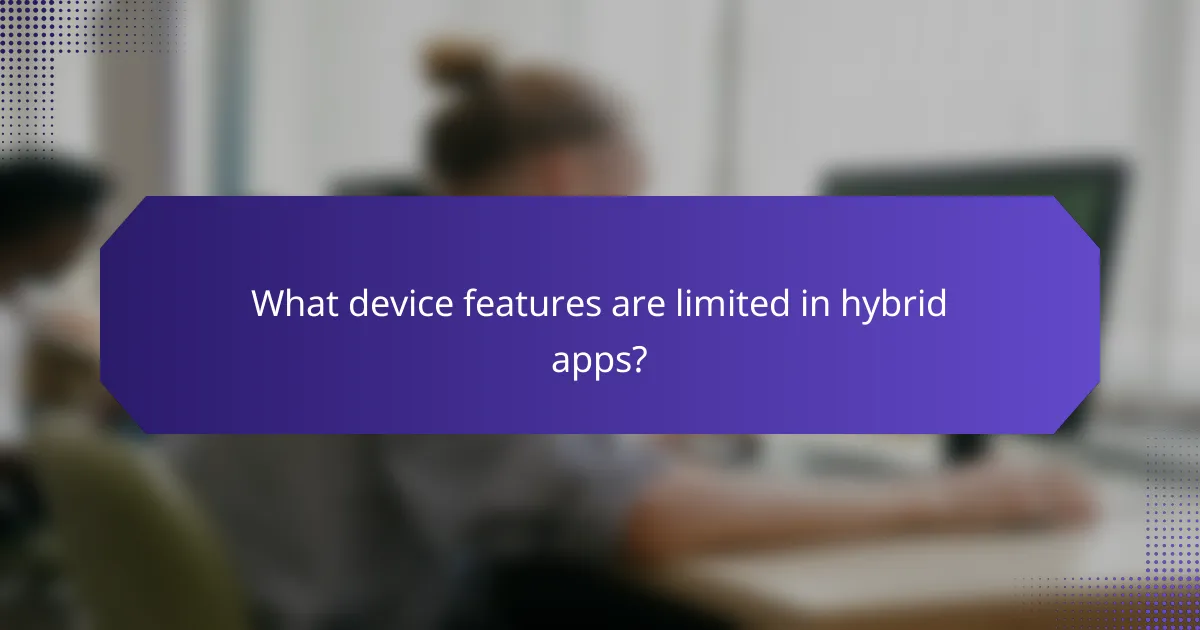
What device features are limited in hybrid apps?
Hybrid apps often face limitations in accessing certain device features compared to native applications. These restrictions can impact functionality and user experience, particularly when utilizing hardware capabilities.
Access to camera and GPS
Hybrid apps may have restricted access to the device’s camera and GPS, which can hinder features like real-time location tracking or high-quality image capture. While many frameworks provide basic access, performance and reliability can vary significantly.
For instance, using the camera in a hybrid app might result in slower response times or lower resolution images compared to a native app. Developers should test these functionalities across different devices to ensure adequate performance.
Limited push notifications
Push notifications in hybrid apps are often less reliable than in native apps due to inconsistent support across platforms. While some hybrid frameworks allow for basic push notifications, they may not support advanced features like rich media or custom actions.
To enhance user engagement, developers should consider integrating native modules or services that improve notification delivery and functionality. This can help bridge the gap between hybrid and native experiences.
Restricted access to sensors
Hybrid apps typically have limited access to device sensors such as accelerometers, gyroscopes, and ambient light sensors. This can restrict features that rely on motion detection or environmental changes, impacting app interactivity.
When designing a hybrid app, it’s crucial to evaluate which sensors are essential for your app’s functionality. If sensor access is critical, exploring native development options may be necessary to achieve the desired performance and user experience.
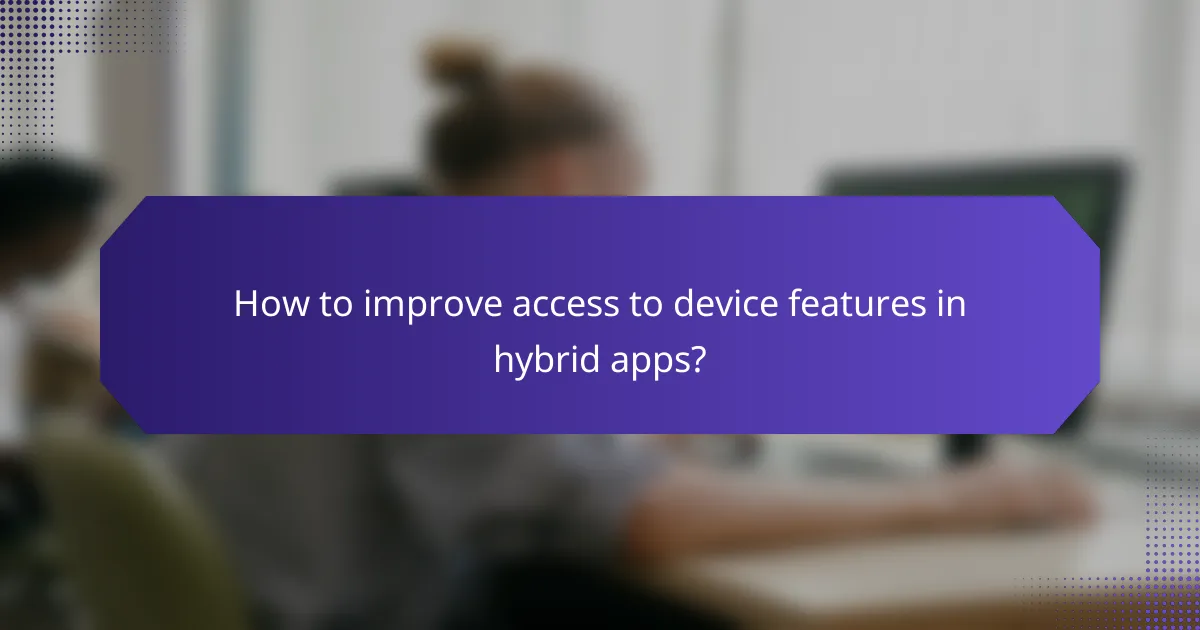
How to improve access to device features in hybrid apps?
Improving access to device features in hybrid apps involves using tools and techniques that bridge the gap between web technologies and native capabilities. By leveraging plugins, native APIs, and considering platform-specific development, you can enhance functionality and user experience.
Utilize plugins like Cordova
Plugins like Cordova allow hybrid apps to access native device features such as the camera, GPS, and file system. These plugins act as a bridge, enabling JavaScript code to communicate with native functionalities, thus expanding the app’s capabilities.
When using Cordova, ensure you select plugins that are actively maintained and compatible with your app’s framework. Popular plugins include the Camera plugin for image capture and the Geolocation plugin for location services.
Leverage native APIs
Native APIs provide direct access to device features, offering better performance and reliability compared to plugins. By integrating native code into your hybrid app, you can utilize features like push notifications, background processing, and advanced graphics rendering.
Consider using frameworks such as React Native or Flutter, which allow you to write components in JavaScript or Dart while still accessing native APIs. This approach can significantly enhance the app’s performance and user experience.
Consider platform-specific development
Platform-specific development involves creating tailored versions of your app for iOS and Android, optimizing each for their respective ecosystems. This method allows you to fully exploit the unique features and user interface guidelines of each platform.
While this approach requires more resources and time, it can lead to better performance and user satisfaction. If your app relies heavily on device features, investing in platform-specific development may yield significant benefits in functionality and responsiveness.

What are common debugging challenges in hybrid apps?
Debugging hybrid apps often involves unique challenges due to their reliance on both web technologies and native components. Developers frequently encounter issues related to performance, compatibility, and access to device features, which can complicate the debugging process.
Cross-platform compatibility issues
Cross-platform compatibility is a significant challenge in hybrid app development, as apps must function seamlessly across various operating systems. Differences in how iOS and Android handle web views can lead to inconsistent behavior, making debugging more complex.
To address these issues, developers should test their apps on multiple devices and platforms. Utilizing tools like BrowserStack or Sauce Labs can help identify compatibility problems early in the development cycle.
Common pitfalls include overlooking platform-specific features or relying too heavily on third-party libraries that may not be fully supported on all platforms. Regularly updating libraries and frameworks can mitigate some of these risks.
